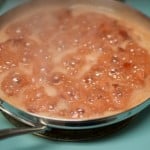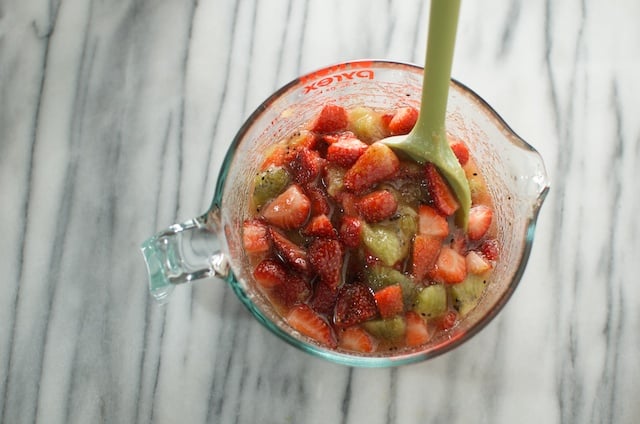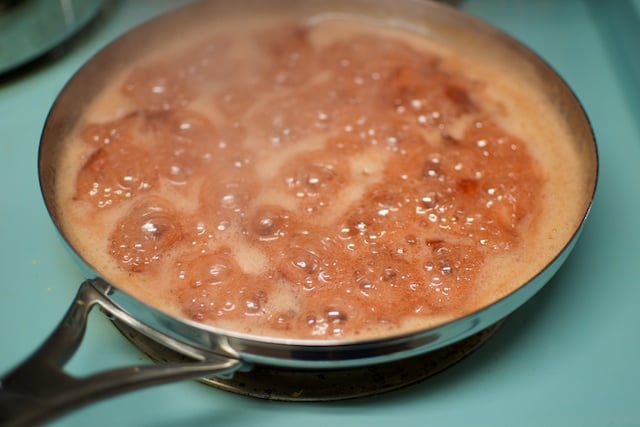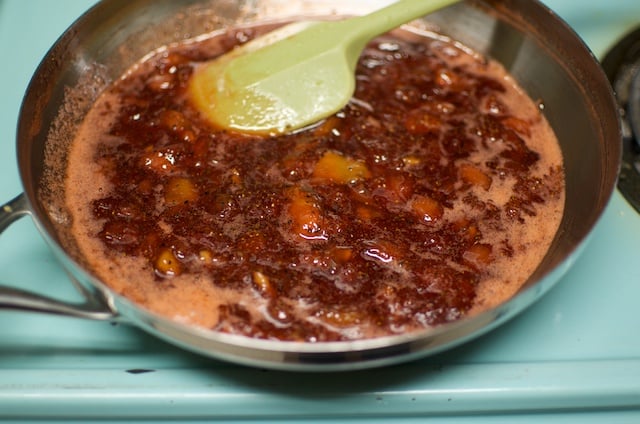When it comes to travel prep, my husband and I are not well matched. He likes to be fully packed at least 36 hours before a trip, so that he can get a peaceful night of sleep before a flight or drive. I am a bit more frenzied, often packing and re-packing my suitcase moments before it’s time to leave. What’s more, my last minute nature extends to preserving projects.
Last December, the last thing I did before putting my coat on to head to the airport was take half a dozen jars out of the hot water bath and turn off the stove. I had a citron melon with a broken rind. It would not last and I couldn’t bare to throw it away. It had to be done.
More recently, I found myself in the kitchen at 11:30 pm, having that familiar debate. Trash can or jam pan? You see, we had most of a pound of strawberries in the fridge that would not last my absence and four wrinkly kiwis that would be well on their way to hooch if left in the fruit basket another four days. I could either bear the responsibility for wasting them or make a quick batch of jam.
And so, I made jam. I followed the formula you’ve all seen me employ before. I chopped the berries, scooped the kiwi out of its fuzzy wrapper, and heaped them both into a measuring cup to eyeball my volume. Three cups. I added in 1 1/4 cups of granulated sugar (I calculate half as much sugar as fruit and then use a bit less than that) stirred until it was juicy. The fruit and sugar combo then went into a skillet, where I cooked it until thick and spreadable (in the last two minutes of cooking, I added a little lemon juice to balance the sweetness).
Instead of being in possession of fading fruit, I had two half pints of tangy strawberry kiwi jam. I may not have gotten as much sleep as I could have used, but I was set free from the guilt of wasted fruit. A fair trade, in my book. And just this morning, I ate a bit on a slice of peanut butter toast and thought fondly of that late night investment of time.
Where do you all fall on the pre-travel canning continuum? Do you preserve at all costs, or do you occasionally let the produce go?

Strawberry Kiwi Jam
Ingredients
- 2 cups chopped strawberries
- 1 cup peeled and chopped kiwi
- 1 1/4 cups granulated sugar
- juice of 1/2 lemon
Instructions
- Combine the strawberries, kiwi, and sugar in a bowl and stir until the fruit begins to release its juice.
- Scrape the fruit and sugar combination into a 12 inch skillet and place over high heat.
- Bring to a boil and cook at a rapid bubble for 8-10 minutes, stirring regularly, until the jam is thick. You can tell it's done when you can pull your spatula through the cooking fruit and the jam doesn't immediately rush in to fill the space.
- When jam is done, you can do one of two things. Simply scrape it into a pint jar, let it cool, and put it in the fridge. Or funnel it into two clean, hot half pint jars and process them in a boiling water bath canner for ten minutes.
- As long as the seals are good, the processed jam is shelf stable for up to a year.





Worked. Great!!!
I just found this recipe and made a double batch today using kiwi, and half and half strawberries (fresh) and blueberries (frozen). It worked out fine, except I had to boil and boil and boil for nearly triple the time (I live at an altitude of 6,000 feet and what a difference it makes!). Great recipe!
High elevation jam making is tough stuff. I’m glad you kept going until you got the right consistency.
I just made this jam…yum is all I can say. I will do it again in a few days. I bought too much produce at Costco yesterday…lol
We got a bunch of kiwis in our CSA box, and neither my fiance nor I love them all to much when eating them plain. So, I tried this recipe and LOVED it. Really delicious, and a great way to use up excess kiwis. 🙂
I’m a big Maldon sea salt fan but to be honest, I’ve never really understood the appeal of fancy salts except for when you need a flaky one for texture. I’ve never tried making my own sea salt, but now that’s all I want to do!
I tend to be the packed and planned 36 hours in advance kind of person while at the same time standing in the kitchen using up the things that would go bad before I returned. I figure that it is the planning part of my brain that allows me to be flexible and put up preserves at the last minute as I hate waste. I’ve made jam, yogurt, or cheese, and baked dinners for our return.
Anyway, the preserves look wonderful and I can’t wait for strawberry season (and kiwis too) to give it a try.
I’m a big fan of low sugar jams. How would I go about making this jam without as much sugar? Pectin?
Mike, I suggest you look at the packet instruction in a box of Pomona’s Pectin. They offer guidelines on how much sugar and pectin to use based on how many cups of fruit you have.
Thanks, I’ll give it a shot.
Last summer the night before our vacation trip I was pitting sour cherries so I could freeze them for later. Later turned out to be February, and I used your recipe for small batch sour cherry jam (only I decided to call mine preserves as it turned out somewhat runny…). I try to freeze as much as I can so I can use it later, especially berries.
The jam sounds really delicious. I am not a huge fan of cooked strawberries (or bananas, I really prefer them fresh) but I think the kiwi would bring a really nice quality to the strawberry jam. I am definitely going to try it sometime…but not so close to having to travel, that would finish me off!
Dang, this sounds so delicious. Strawberries are one of the things I just can’t let go to waste either. Last summer I had a bunch of extras on the brink a couple times and froze them to use in smoothies. Mmmm strawberries.
Here’s a man’s answer to leaving fresh produce behind.
What do you do to make jam: you cook it. What about vegetables: cook them to. When you cook these fresh foods, it often makes no difference if you cook fresh, or frozen. So theres another option: freeze until you get back, and then prepare the frozen goodies same as from fresh. I did this with a bag of lemons. Thaw one out, juice it and its perfect. Apples, made applesauce. Tomatoes: make bbq sauce for man-food: ribs! Most frozen veggies are fine for soups, and my dogs love cooked veggies with a little chicken. But this way you gals can deal with it later and then spend exorbitant time packing the wrong color heels with the right wool socks. 😉 We guys don’t worry about mismatched socks because they come that way. Proof: we have another pair just like it at home.
Freezing works within limits. Frozen lettuce is good for worm beds so we can go fishing and enjoy other cold things… Frozen watermelon, hmm, cannon balls!
Frozen berries work very well for jam. My mom and I have been using them for a long time. Sometimes there’s just no time to make jam when you’re faced with a flat of strawberries or you really want raspberry jam but the price of enough fresh raspberries will be too much. Well, strawberry jam from berries I’ve frozen myself doesn’t taste any different from jam made with non-frozen berries.
I had this exact dilemma on Tuesday. I discovered a few oranges & apples that were fading fast. I ended up with some delicious orange marmalade & a small jar of apple butter. Yum! It was a deja-vue feeling while reading your post. Love it!
Old fruit doesn’t usually go to waste in my house…it goes up to my barn for my potbelly pig and chickens to eat. The pig loves apples, melons, grapes, stone fruits, tomatoes, cucumbers…anything but citrus. The chickens will eat melons till their rinds are practically see-through! So, although I would rather not let it go…produce doesn’t go to waste at my house. Apples get a bit old, pears a bit soft or cucumbers have a bad spot or even lettuce gets a bit old…off to the pig and birds it goes.
I tend to toss things in the freezer as well. Matter of fact, as a prelude to ACTUAL spring (as opposed to this snowy crap we’re dealing with right now), I’m pulling out the jam pot this weekend to use up some plums, peaches and pears I set aside last summer 🙂
Not canning so much as throwing in the freezer because that’s how close I cut it. I generally have about 10 minutes to do whatever with the produce in the fridge that’s not going to make it.
With the cost of food products, produce, I just don’t have the heart to throw away anything. If not eaten right away then it’s prepared for the freezer. I have 20 lbs. of potatoes (bought on sale) that I have been cutting /making homemade fries and putting in the freezer.
My canning I have to do in the very early hours in the morning…..usually before sunrise. I’m an early to bed; early to rise type of person.
Thanks for the strawberry kiwi jam recipe. I will have to can some up sometime.
Enjoy your day and have a wonderful weekend.
I’m with you Marissa. I abhor waste. *If* I don’t have time, which is more often than not the case, I will prep the fruit or veg and freeze it.
Brilliant idea – when the house was full of little ones – I canned alot – then sort of gave it up – this has given me new inspiration
I’m pretty much out of jars at this point (already!), so I’m more likely to dehydrate things than can them for a while. I just don’t have the storage space for jars either, so until we use some of what I already have, I will continue to use my dehydrator. I’ve been saving up for a regular size Food Saver vacuum machine, and with the cash I now have set aside, along with Christmas gift cards, I’m ready to take the plunge. Shriveled dried packages are lightweight and take up far less space than jars. I can put a whole meal into a small, light, vacuumed bag, and since it will again be hurricane season soon enough, that’s something I can take with me to a shelter, along with my tiny backpacking stove if evacuation is a possibility. I delight in donating some of my dehydrated meals to our community food bank, too. What’s a leftover for me is a needed meal for someone else, and I’m not giving up a precious jar to do it, just a plastic bag.
I think it’s awesome that your food bank will take home made food. Go them! And go you for doing it!
What do you put together in your meal packages? And how to do use them when the time comes?
I just got my brand new Food Saver on Friday, but until then I have been using the $20 hand-held vacuum they make, with the Ziplock bags that have the vacuum “hole” on them. They work well! I dry lots of carrots, mini sweet bell peppers, and onions, and those go especially well with the beef Ramen noodles. I add some garlic powder, parsley, and thyme to the packet. It’s very inexpensive to produce several for our local food bank. The noodles cost me 20 cents, and the small amount of veggies & herbs/spices I add are probably less than a nickel’s worth. My Hubs and I often eat these for lunch, too, and they are fast, easy, and nutritious. I usually add any leftover vegetables such as asparagus, cauliflower, snow peas, regular peas or corn, and really, just anything that’s in the fridge that won’t stretch for another meal’s side dish. I add leftover chicken or beef or pork, too. Anything goes!
I live in an over-55 community and we have our own food bank. The ones in the town might not take them, but we seniors trust each other . I’m going to work on putting together a dehydrated tortilla soup packet, too, which will also be very economical. When we have a hurricane that knocks out our power for up to a week (has been longer) we have to have a way to have a nutritious meal, and many elderly must eat in order take certain medications. The most elderly are fragile and need special support during those times, which, thank goodness, are rare. Most of us have a BBQ or some way to boil water. To prepare one of my MMRE packets (that’s short for Moms Meals, Ready to Eat) you’d just empty the packet in a bowl, cover it with boiling water, cover it and let stand for about 10 minutes. I would make them for the Operation Shoebox that we operate for the troops here, but again, my ingredients could be seen as “suspicious”, which is a shame. When out in the field, our troops need at least one hot meal per day.
I also took Marisa’s suggestion about the one-pot “canner” she uses, bought one, and it is a real beauty! If you can only do one jar at a time, the Kuhn Rikon 4th burner pot is superb. I bought mine at Amazon, and it is much nicer than the picture shows. It has an improved handle, and is a heavy duty workhorse for all sorts of things!
http://www.amazon.com/Kuhn-Rikon-4200-12-Cup-Burner/dp/B00381ANTG/ref=sr_1_8?ie=UTF8&qid=1396279896&sr=8-8&keywords=Kuhn+Rikon
Canning and dehydrating will see us through a natural disaster for a long time, and our nutritional needs will still be met fully. These are not just good things, they are very necessary things to do for your family. We have so many natural disasters all over our country, and people need to eat; the victims, the first responders, the neighbors, and the support personnel. We often need to shelter in place, and you can be comfortable, or you can be hungry. I wish right now I could feed those who are trying to recover the bodies from the horrible mud slide in Washington. A hot meal gives one stamina and hope.
P.S. I try to get my freezer nearly empty from June 1 to Nov. 30 because that’s hurricane season, and if the power goes out for many days, I could lose everything. By June 1, I will keep no more than 5 or 6 days’ worth of frozen food. Canning and dehydrating give me FAR more options since I know that food won’t spoil!
I grew up in tornado alley, and I live in hurricane heaven, so emergency preparedness is a way of life. The West Coast dwellers have their earthquakes, the Midwest their tornadoes, the far north has their blizzards, and we East Coast dwellers have hurricanes, (which can spin off tornadoes), unusual cold spells as in this past winter, and floods. Disasters never stop for long.
My husband and I were in Washington, D. C. on 9/11/01, and even there, on a temporary assignment, we had backpacks with emergency supplies and could have hiked out if it had become necessary. There are many emergency preparedness sites on the internet, many great ideas on Pinterest, and lots of companies that make freeze dried food if you want to use it instead of drying your own. Check it out, think about it, and provide for your family. You will be so glad you did.
Just before a trip, I preserve by freezing! I have never done such tiny batches – I usually consider preserving/canning a full-day affair.
I’m totally 100% with you. I can not throw food away – especially not strawberries! Also, I’ve been known, during harvest season, to be stirring tomato sauce on the stove up until the minute before we head out the door for a camping trip.
It depends. For those of us with a compost pile, it’s not a total waste. That being said, I hate putting things in the compost that might have been delicious. I’m not normally interested in canning late at night – I’m too tired and therefore it strikes me a slightly dangerous – but I will put the fruit and some sugar in a ziplock bag and then throw the whole thing in the freezer. I always label the bag with the quantity of fruit and sugar so when I get around to canning, I know where to start. This worked pretty well last summer when there were some very ripe apricots at the Farmer’s market a week later than expected, on a weekend when I couldn’t do any canning. Made a nice little October project weeks later.
Honestly, I’m pretty sure I got this tip from you!
Have you ever thought about prepping and freezing the fruit? Especially if you put sugar in it, I cannot tell a difference in taste (though maybe some could? I don’t know). Lovely jam!
Ha! I’m with you….last summer we went to Europe for 3 weeks, just as strawberry season was coming in. I knew that by the time we got home, the berries would be gone, so I made a LOT of jam the day before we left. And we’re all happy about that now, although my partner was laughing about it at the time.